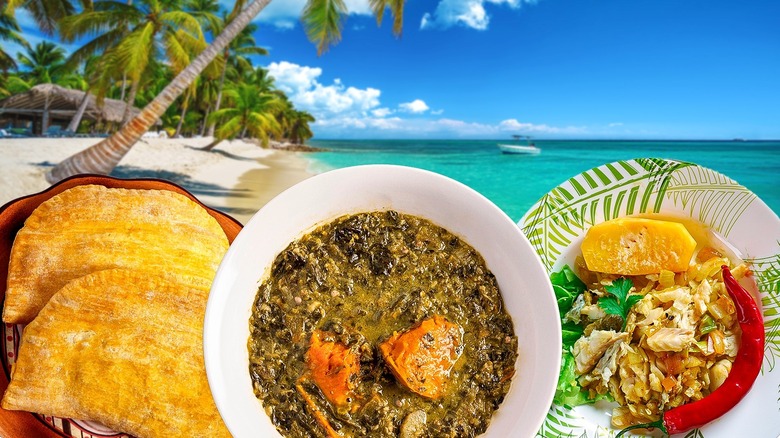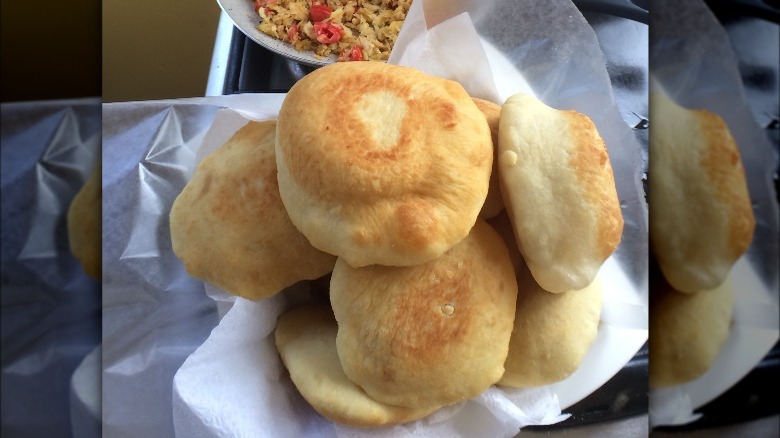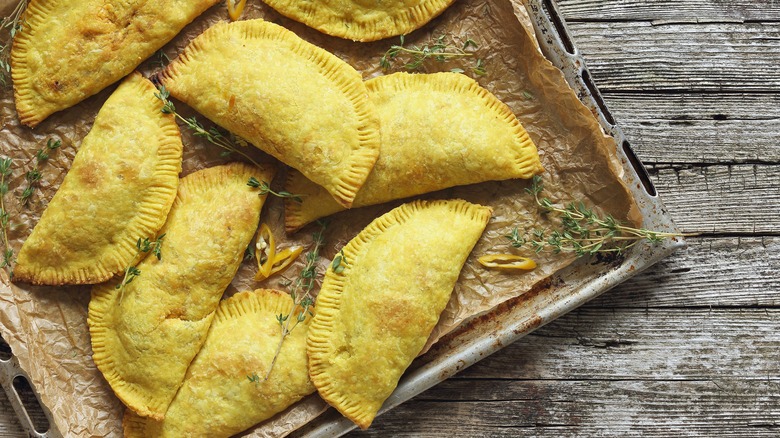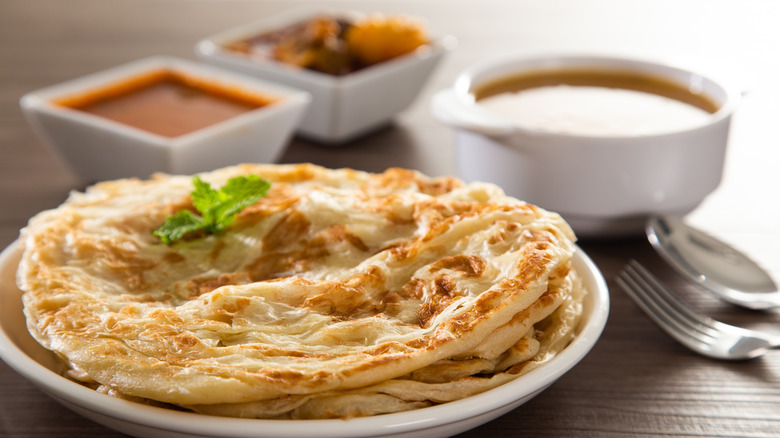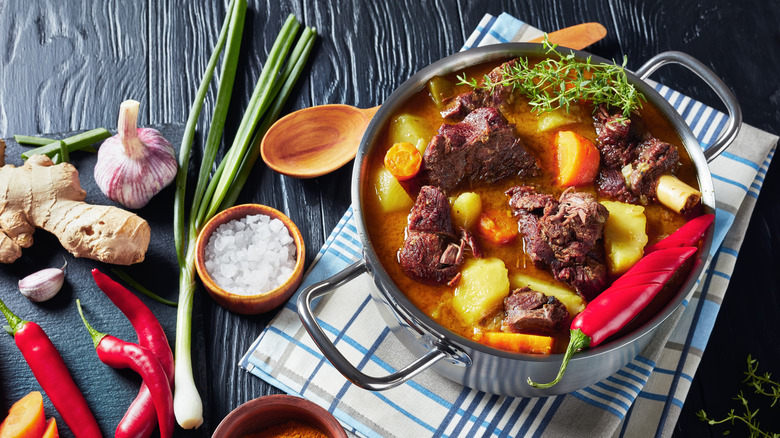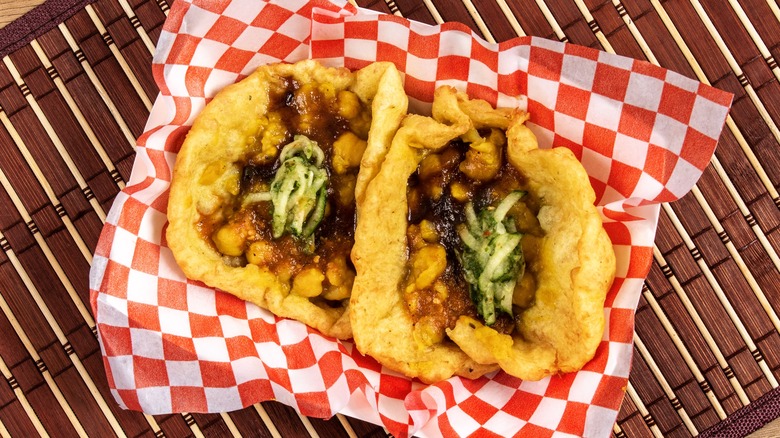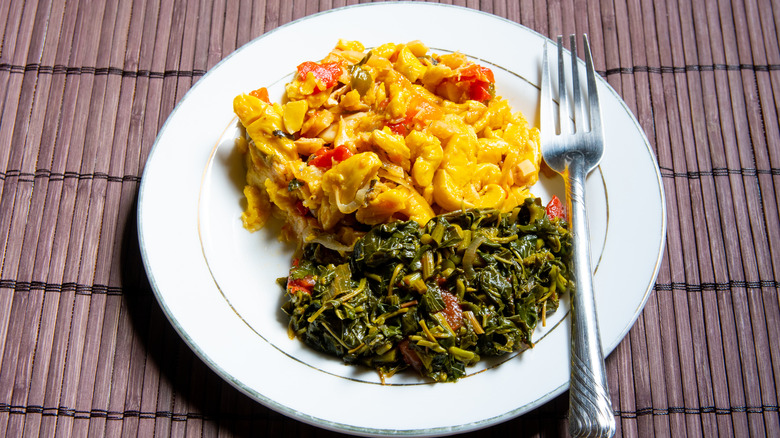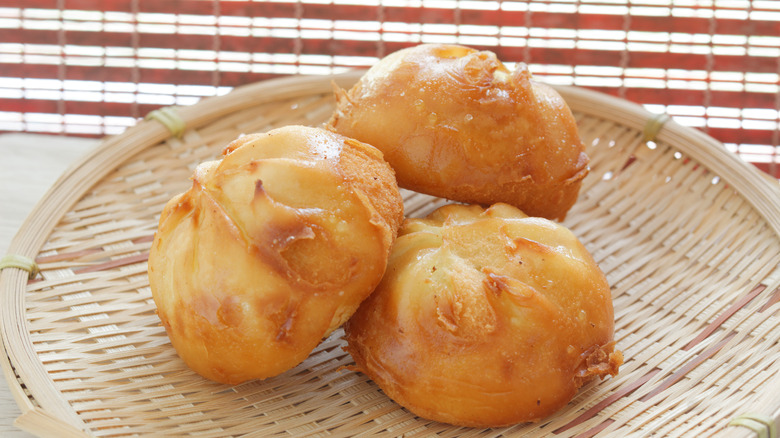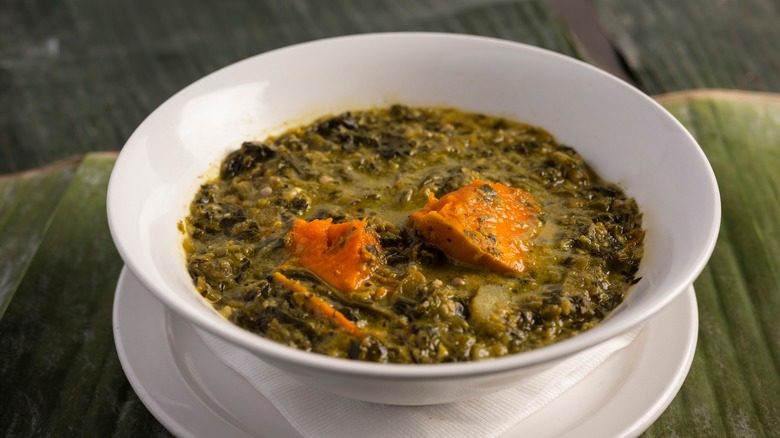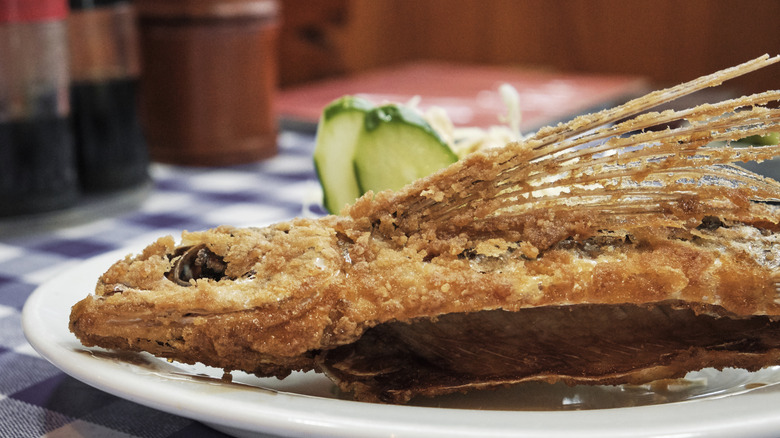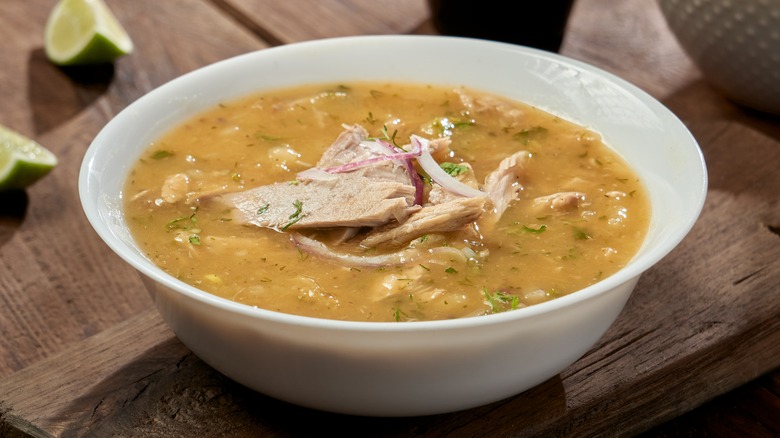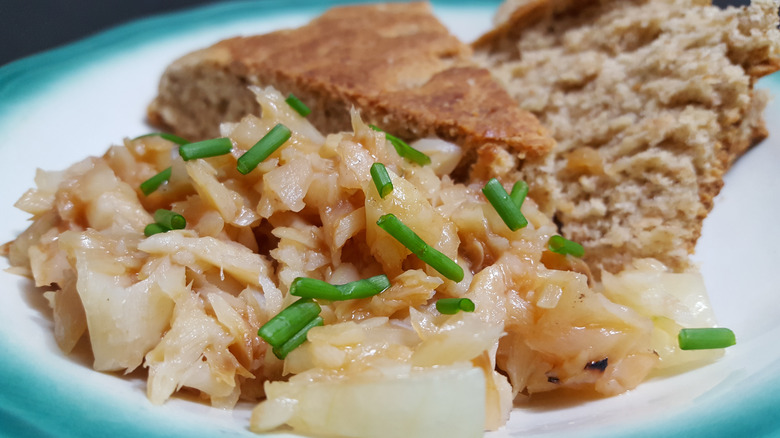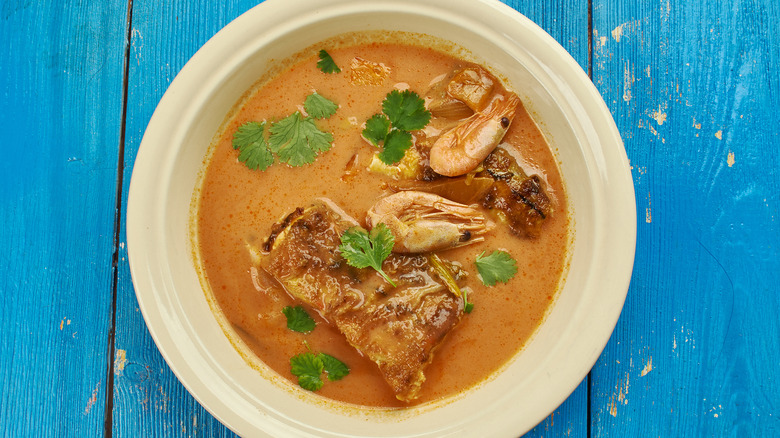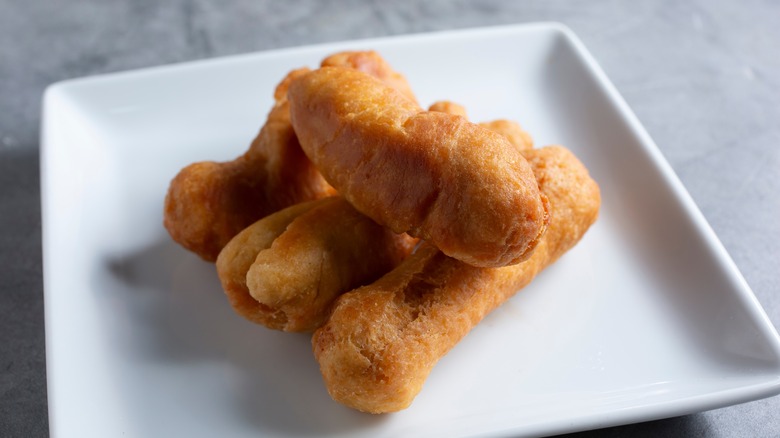Caribbean Dishes Experts Recommend You Try At Least Once
Whether you're into Caribbean cuisine or you're looking for new foods to try, you might be interested in discovering some classic dishes from the region. But, the Caribbean is a collection of more than 7,000 islands, islets, and keys, comprising 13 independent nations and many non-sovereign territories — so you can hardly expect all Caribbean food to be identical.
Rather, each nation or region has its own cuisine with a unique blend of influences. For instance, Martinique's cuisine draws inspiration from the island's French colonizers, while still using produce and flavors local to the area. Although food differs between countries, there are some common hallmarks of Caribbean cooking, such as the use of coconut, chiles, and fragrant spices, such as nutmeg and cinnamon.
We spoke to three experts in Caribbean food to discover their favorites. Based on this, we compiled a list of the Caribbean dishes you need to try at least once. You can learn more about their origins, influences, and ingredients, all the while adding more items to your culinary bucket list. These aren't the kind of dishes you'll find in a Caribbean chain restaurant. Instead, they're approved by Caribbean chefs and experts in the cuisine of these island nations.
Bakes
Bakes are a favorite of Nina Compton, a chef who hails from St. Lucia and owns Compère Lapin and Bywater American Bistro in New Orleans. "Some call them warm bakes, some call them hot bakes, and many of us just call them bakes," she says. "Regardless, I love these pieces of fried dough filled with cheese or garlicky butter, and when I'm back on St. Lucia, I get them at Pink Plantation House — it's on the top of the mountain in Castries."
They're essentially partway between dumplings and bread rolls, made from a dough that's usually yeasted but occasionally made with baking soda — though these versions are flatter and less pillowy. The dough can contain fragrant spices, like nutmeg and cinnamon. Since they're more often fried than baked, in some parts of the Caribbean, they're known as fry bakes.
While Compton likes them with cheese or garlic butter, there are a range of ways people enjoy bakes in the Caribbean. They're often eaten for breakfast, especially on weekends, and are often enjoyed either with saltfish or simply sprinkled with some powdered sugar. They can be served with basically any savory dish or cut in half and spread with butter or filled with various ingredients.
Jamaican patties
If the word "patty" makes you think of burgers, you might be surprised to learn that a Jamaican patty is more like a hand pie. The outside consists of a flaky pastry that's lightly spiced with curry powder and gets a golden hue from turmeric. Inside, there can be a range of meat or vegetable fillings — but the one thing they all have in common is that they're generously spiced.
This dish was recommended to us by Daniel Chin, director of operations for Juici Patties in the USA. "Jamaican patties are an icon," Chin says. "There's actually a debate going on, wondering why Jamaican patties aren't the national dish of Jamaica because they've been a part of our culture for so long, and they've always been affordable for everyone."
Want to make them yourself at home? There are plenty of recipes online — such as this Jamaican beef patty recipe. They're also often found in supermarkets, ready to eat. Of course, they'll likely be better from a good Jamaican or Caribbean restaurant.
Curries and roti
We spoke to Jeanine Prime, owner of Trinidadian restaurant Cane and modern Caribbean restaurant St. James, both in Washington, D.C., and her first recommendation was for curries and an assortment of rotis, such as dhalpuri, paratha, and dosti. Not up on your flatbreads? Dhalpuri is thick and stuffed with yellow split peas, paratha is flaky and layered, and dosti is soft, fried, and layered.
"Curries come in all varieties, including chicken, shrimp, conch, goat and vegetarian," says Prime. She explains that they were "brought to the Caribbean by Indian immigrants who moved to the region post-emancipation" and became part of the region's food traditions but with a Caribbean twist. For instance, Jamaican curry powder differs from a more typical flavor profile for Indian curries thanks to the addition of allspice, Scotch bonnet, and sometimes star anise.
"This is just the ultimate, shareable family-style meal," says Prime. "It's the centerpiece of all the celebrations and gatherings and is universally loved around the Caribbean region and beyond." For the best experience, we'd recommend getting your curries and roti from a good Caribbean restaurant. However, it's also possible to make a good version yourself at home with some practice and attention to ingredients.
Curried goat
While there are all kinds of Caribbean curries to enjoy, curried goat is a particular favorite for many. "Curried goat originated in India but was brought over and became a staple of Jamaican cuisine," says Nina Compton, adding that "you can also find it on many other islands." So, there are plenty of variations that you can explore. It won't be exactly the same version from one chef to another, and that's part of the beauty of it.
Compton loves curried goat because "it's hearty and packs a ton of flavor." It generally includes a lot of spices and aromatics, such as ginger, garlic, allspice, thyme, and cloves, so there's a lot going on with this dish. "It's one of my signature dishes at Compere Lapin and is served there with sweet potato gnocchi," says Compton. As with most dishes on this list, you'll have the best culinary experience trying it at a neighborhood Caribbean restaurant with a good reputation. If you tried it at a chain restaurant and didn't like it, that's no big surprise.
Doubles
Jeanine Prime recommends doubles as a Caribbean dish that everyone should try. It hails from Trinidad and Tobago, where it's a popular street food. The recipe "consists of bara filled with chana," she says. Bara is a soft, fluffy, fried flatbread made from flour, water, and a blend of spices like turmeric and cumin, giving it a golden hue and aromatic profile. Chana means chickpeas — these are nicely spiced, simmered with garlic, onions, cumin, and other aromatics. You get two bara — which is probably why the dish is called doubles — and these are either topped with chickpeas or the chickpeas are tucked between the two.
"This is quintessential street food that is good for breakfast, after a party, or any time of the day, really," says Prime. "It's so simple and satisfying, and is an entirely vegan dish, equally enjoyed by vegans and meat-eaters," she adds. While the best place to enjoy it is on the streets of Trinidad and Tobago, you can also find it in Caribbean restaurants in the U.S. — or you can make it yourself.
Ackee and saltfish
Ackee and saltfish is another dish to put on your shortlist. According to Nina Compton, it "is one of Jamaica's classic dishes with dried salt cod, ackee fruit and usually served with warm bakes." First off, you might be wondering what ackee is and what it tastes like. Ackee is a fruit — in fact, it's Jamaica's national fruit — but it's more often cooked and eaten like a vegetable in savory recipes. "Ackee fruit has a soft texture and a bit of nuttiness in taste," Compton notes.
In this dish, it's paired with saltfish, a dried, salt-cured fish. "It tempers the saltiness and firm texture of the saltfish," she remarks. Other seasonings and ingredients in this dish vary depending on the recipe, but can include thyme, bell pepper, scallions, and Scotch bonnet peppers. Compton likes it "with some smoky paprika and a bit of heat." She adds that "the dish is full of flavor and texture." You'll often find a variation of this classic dish on Caribbean restaurant menus in the U.S. If you're lucky, it might even come served with bakes.
Pork pow
This Trinidadian dish is a favorite of Jeanine Prime. "Pork pow are essentially steamed buns filled with ground pork spiced with ginger, garlic and soy sauce," she says. They're very similar to Chinese bao buns — and, in fact, the name "pow" is likely a variation of "bao," changed over the years.
Prime notes that there's a "significant Chinese community in Trinidad, many of whom came to the region after the emancipation of slavery, much like our East Indian community." And, this is how a traditional Chinese dish came to be a Trini favorite with a Caribbean twist. "This one is very nostalgic for me as it's a snack I would often enjoy when my mom would pick me up from school," Prime adds.
Pow — pork or otherwise — aren't common on Caribbean menus in America. This is perhaps due to their similarity to Chinese bao buns and the fact people don't expect to find this kind of food at a Caribbean restaurant. You may find them at some Trinidadian restaurants in the U.S.; otherwise you'll just have to take a trip to Trinidad. You certainly won't find us complaining about that prospect.
Callaloo soup
Callaloo soup is something you have to try before you die, according to Nina Compton. Before we get into the details, you might want to know what the main ingredient is. "Callaloo is similar to spinach and was brought from West Africa," she explains. It looks a lot like spinach and can be used in similar ways, but it has a stronger flavor with some bitterness to it.
But, what about callaloo soup? "It's a traditional Caribbean soup that comes from Trinidad and Tobago, but many Caribbean islands have adopted it as part of their cuisine," Compton says. This means there can be a range of variations from region to region. "In Trinidad they use dasheen/taro leaves but other islands tend to add meat to the soup," she notes. "You can't go wrong either way, it's delicious."
When making the dish, the callaloo is generally blended to make a smooth soup. If the specific recipe includes meat, seafood, or dumplings, these are added after the soup has been blended, so that the soup base is smooth but it has chunky bits in it. This makes it more of a filling main dish option.
Flying fish
Flying fish are popular in Barbados, but have made it to other Caribbean islands, as well. Jeanine Prime is a big fan. "These small fish are just delightful," she says. "You can put the whole thing in your mouth or enjoy the entire thing in just two bites. They are small but meaty, crisped to perfection and are just the perfect bite."
Flying fish can be prepared in a range of ways. Flying fish and cou-cou is the national dish of Barbados and seems like a great place to start. It consists of a fish stew (which includes flying fish, naturally) on a bed of a Bajan cornmeal dish known as cou-cou. It's also regularly enjoyed battered and fried or fried with cornmeal or corn flakes and flavorful seasonings.
It's rare to find flying fish on the menu outside of Barbados (and surrounding Caribbean regions), so you'll have to go quite a distance to try it. However, you should perhaps think twice before eating it and try a different Bajan classic instead. "Sadly, they are facing some challenges due to climate change and overfishing," Prime explains. If you're interested in trying it at home, without the worry of overfishing, some recipes that traditionally contained flying fish recommend using sea bass as an alternative.
Seafood pepperpot
If you love seafood and coconut milk, you're bound to enjoy seafood pepperpot. "This Caribbean dish highlights the bounty of island seafood and has many Caribbean spices and flavors like lemongrass, star anise, and coconut milk," says Nina Compton, who made this recommendation. It has some kick to it from Scotch bonnet, but generally relies on milder favors.
Like many Caribbean dishes, you'll find a range of variations. Seafood pepperpot itself is a variation on classic pepperpot, which is Guyana's national dish and uses meat rather than seafood. Compton's version is a "soup that's then poured over shrimp just as you're ready to serve" but some are more like stews, with a range of seafood cooked up with the coconut milk and spices.
If you choose to make it at home, you should use fresh seafood and high-quality coconut milk. Just make sure you know the difference between carton coconut milk and canned coconut milk. The stuff in the carton is meant as a milk replacement, while the canned variety is thicker, creamier, and perfect for recipes like this one.
Buljol
Buljol is our final recommendation from Jeanine Prime. "This is a salad dish made of salted cod, chopped tomatoes, hot peppers, garlic, and onion," she says. "It's often served with floats, also called fried bakes in different islands." She adds that it's a Trinidadian dish, but it's also popular throughout the Caribbean. There are a range of ways to make this dish, so some may be heavier on the saltfish than the tomatoes and other veggies.
As it's a salad, it's fairly simple to prepare. The most in-depth part of the process is boiling the saltfish to remove excess salt. Aside from that, the process mostly involves chopping. So, it's an easy Caribbean dish to try at home, if you're looking to get started with cooking food from this part of the world. That said, the best examples will come from a quality Caribbean restaurant — or, better yet, from Trinidad and Tobago. "It's the perfect brunch food paired with floats," says Prime. "The floats are airy on the inside forming the perfect pocket to enjoy the buljol."
Rundown
An unofficial second national dish of Jamaica, rundown is a rich stew made with coconut milk. The coconut milk is cooked for a long time, and thickens until it reaches a custard-like consistency. In Jamaica, it's a popular breakfast food and it may be served with boiled green bananas, cassava dumplings, or other vegetable sides, commonly known as ground provision — or just provisions.
You'll find many variations on rundown, but the version that uses salted mackerel is probably most common. Vegan or Ital versions use a variety of vegetables instead of fish. But, it's really the coconut sauce itself that's the rundown, so any other ingredients (within reason) can be added to make up the body of the stew. It's flavored with garlic, scallions, onion, allspice, and thyme — plus a hefty dose of Scotch bonnet chiles.
As it's considered a breakfast dish, you won't often find it on menus at Caribbean restaurants, so if you're interested in trying it, you may want to think about making it yourself. It's fairly time-consuming to prepare, but it's worth it. In Jamaica, people often make it on the weekends, when there's ample time to make and enjoy it.
Festivals
A festival is a type of Jamaican dumpling. There are so many dumplings out there, with many types of Chinese dumplings, Eastern European dumplings, and so much more. You could even consider ravioli a dumpling. Festivals, however, have more in common with the type you'd find in traditional chicken and dumplings, in as much as they're basically bread all the way through, rather than having a filling. But, that's really where the similarities end.
Festivals are unlike any dumpling you've eaten before. They're fried, which gives them a crispy exterior that contrasts the soft, yet slightly crumbly interior. They're long and thin in shape and are made from a mix of cornmeal and all purpose flour. Cornmeal is commonly used in Caribbean cooking, dating back to a time when these islands were inhabited by enslaved people, who were given weekly provisions of cornmeal and saltfish by plantation owners.
The dough is sweetened with brown sugar, and they sometimes even have vanilla extract or cinnamon added to them, which gives them a dessert-like quality. However, you can eat them as a side with all kinds of savory dishes. They always make it onto my plate when I eat at my favorite Caribbean restaurant.
